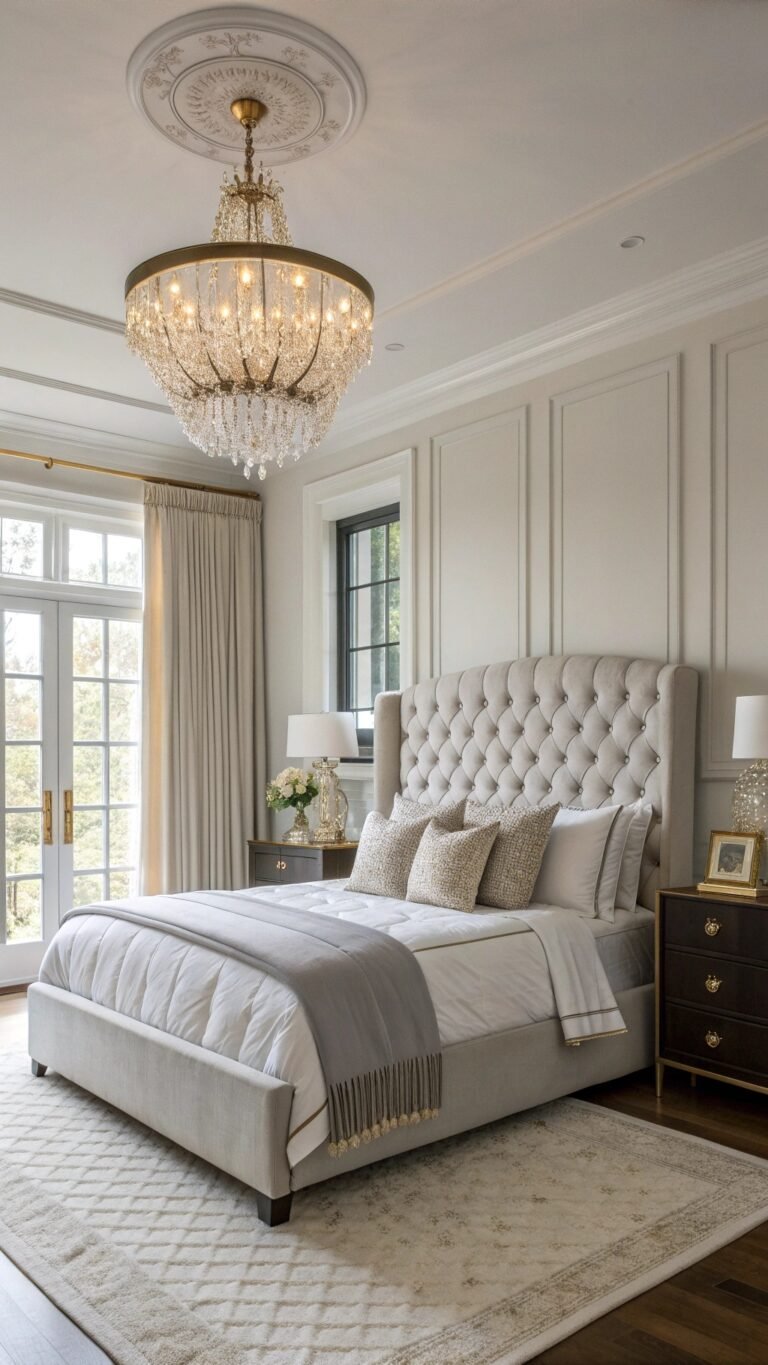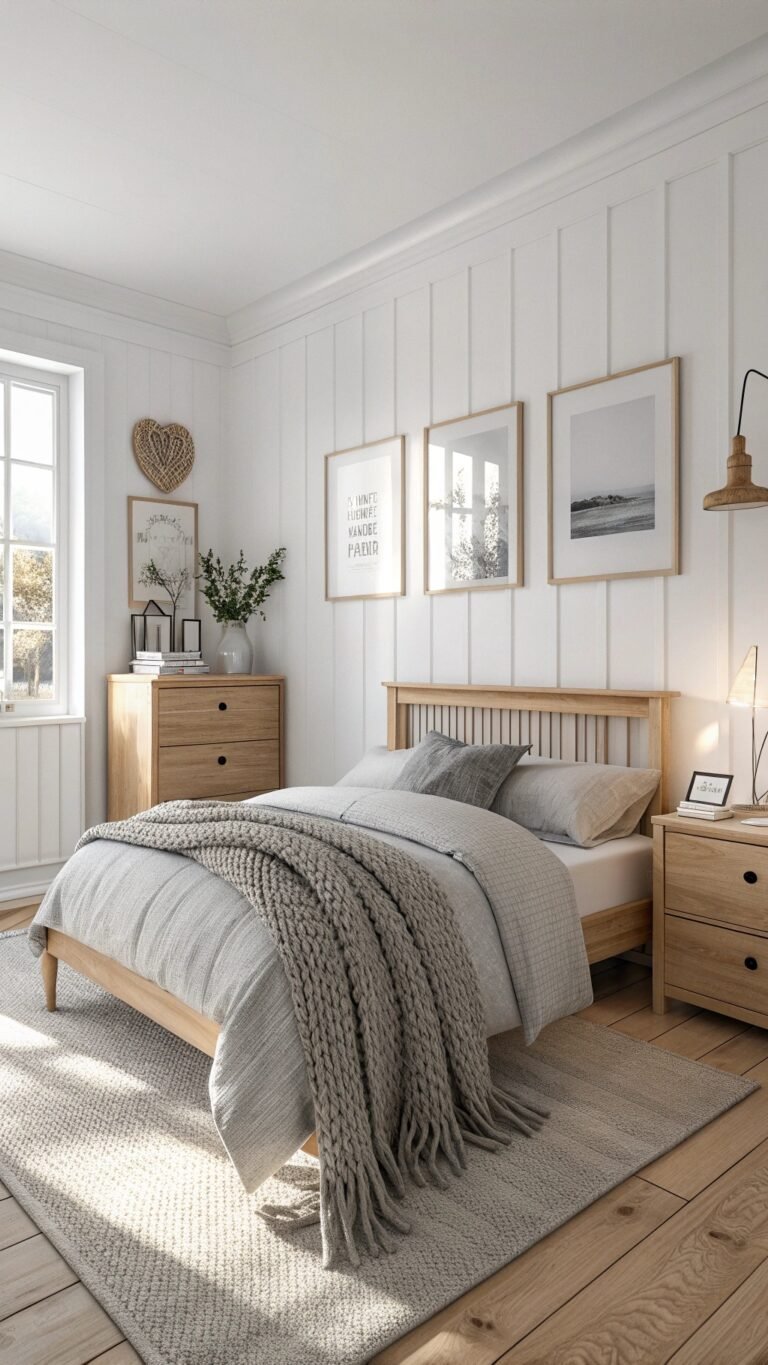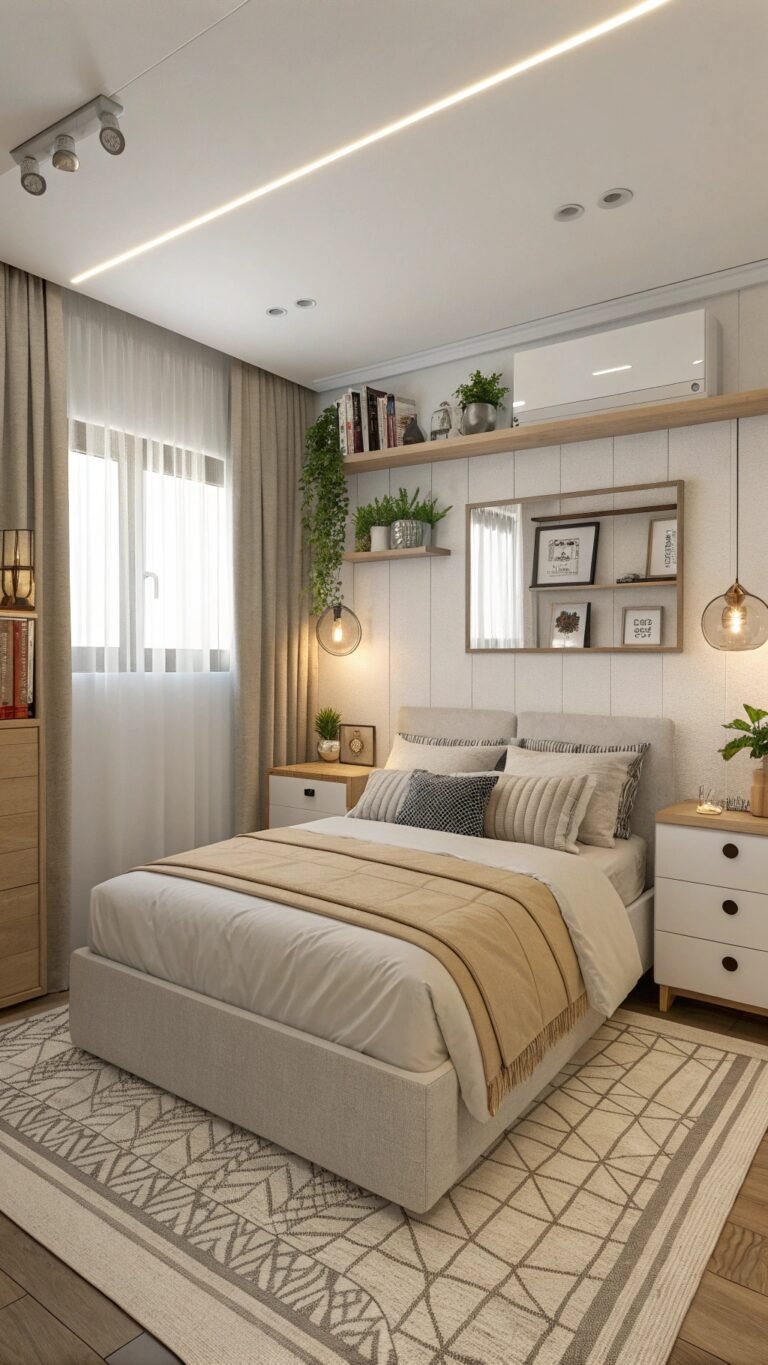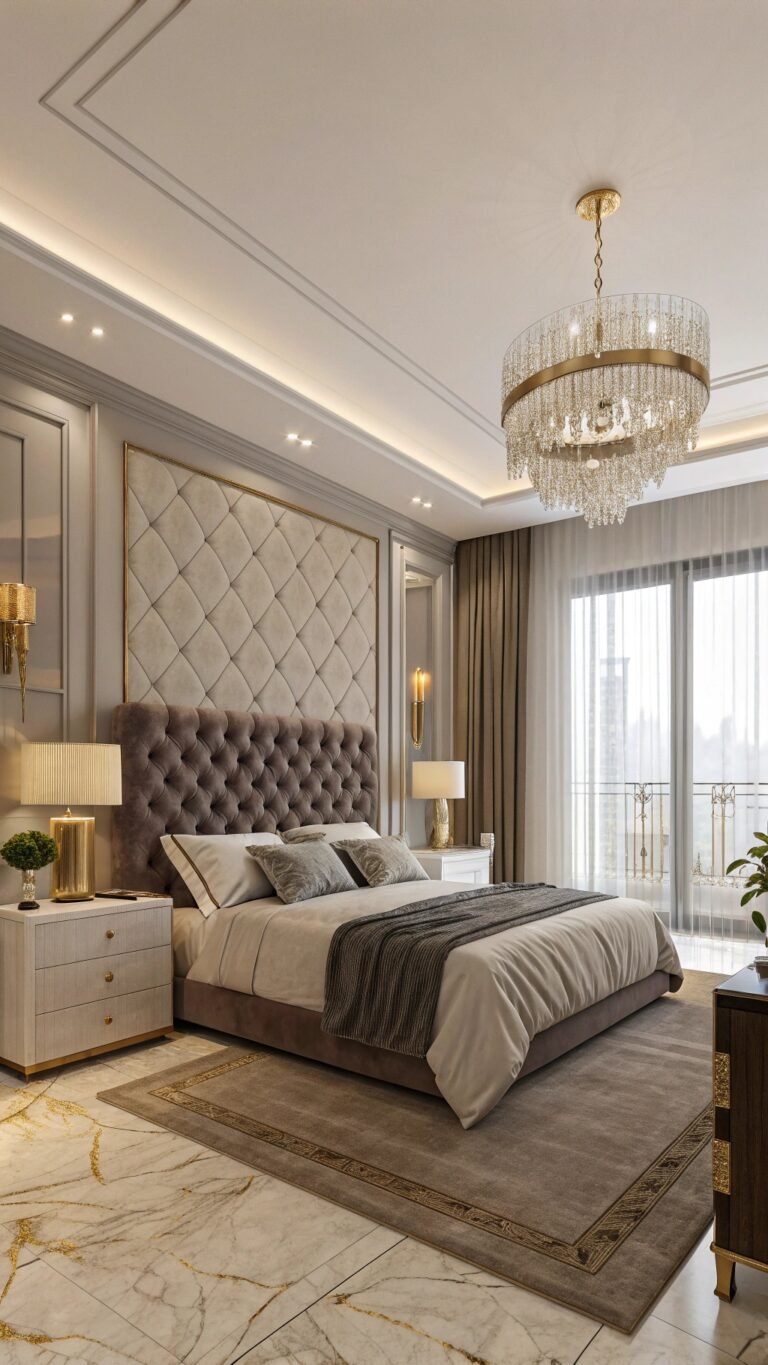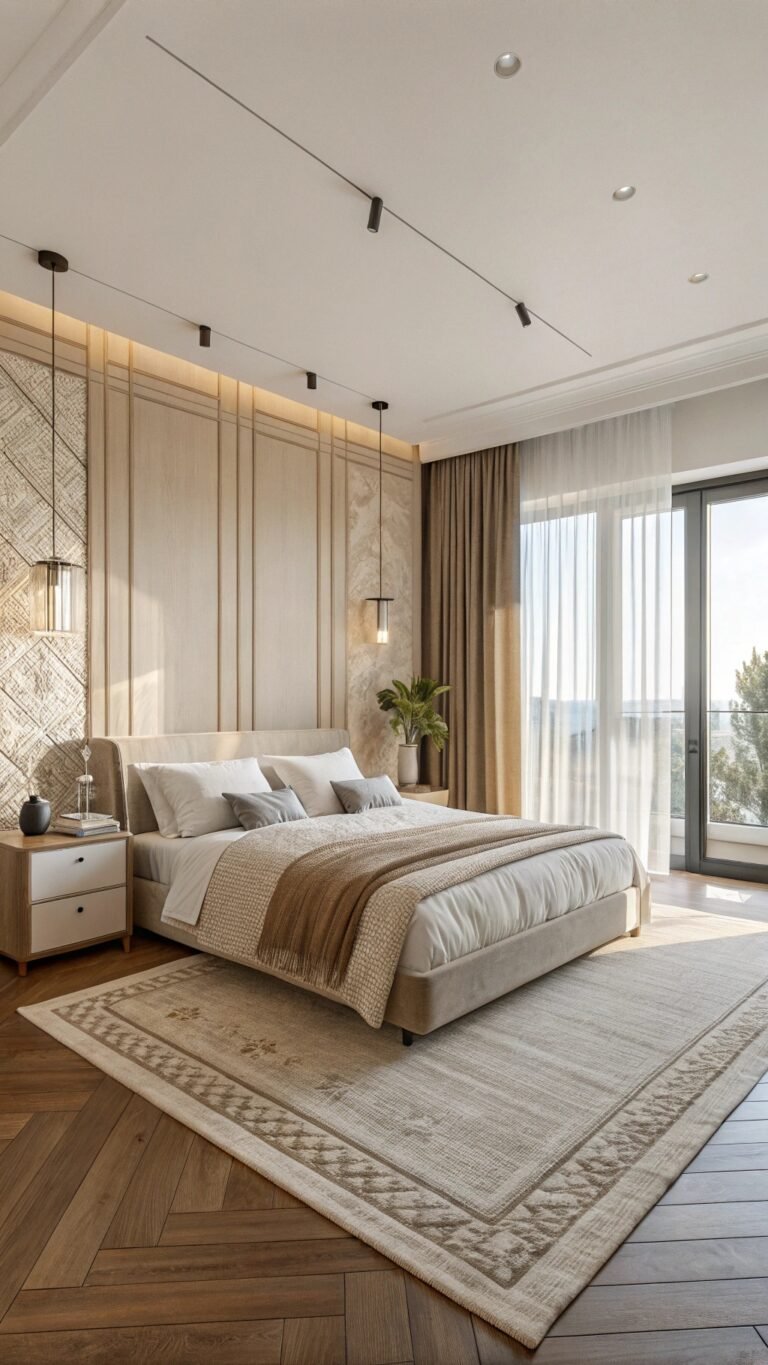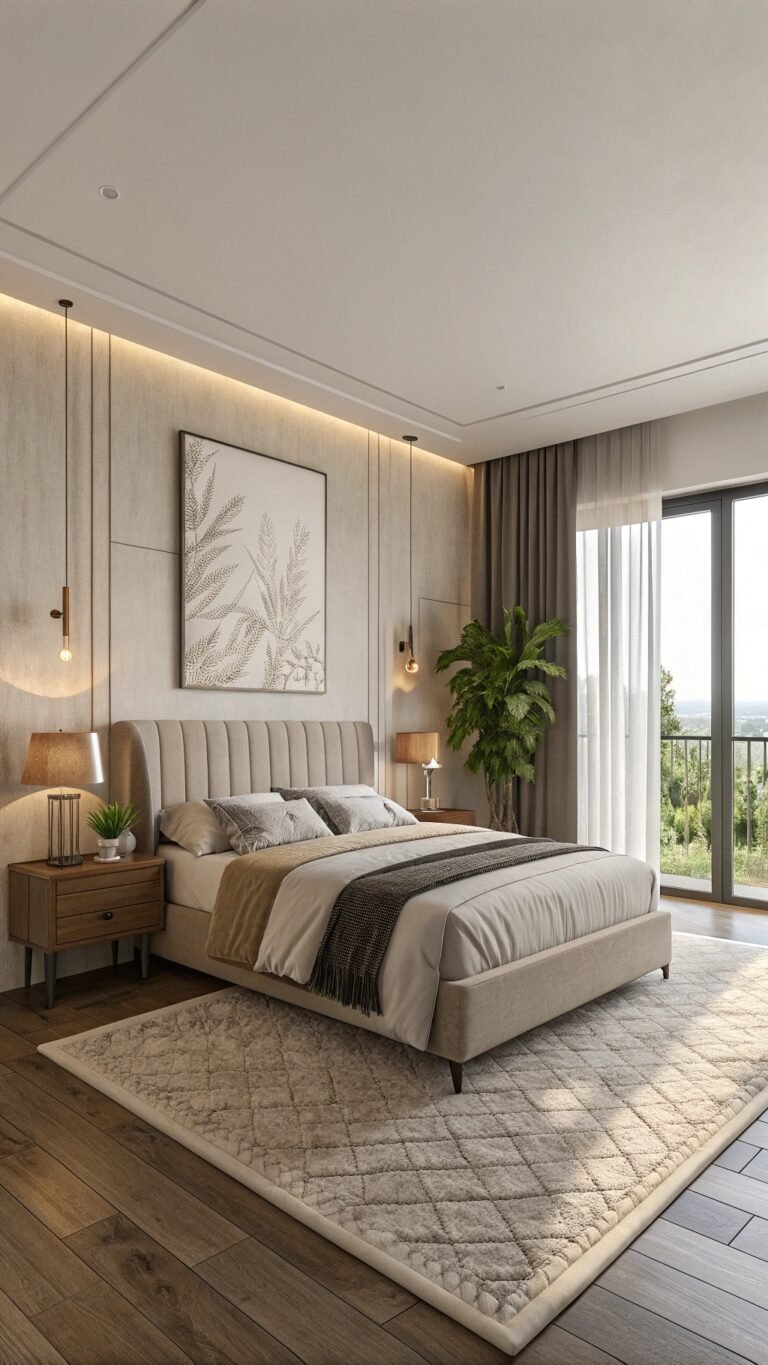Minimalist Bedroom: 18 Calm, Edited Looks That Still Feel Warm
Minimalist bedroom style is surging because it delivers instant calm without expensive renovations. By editing furniture, tightening palettes, and letting light and texture do the work, small tweaks feel transformative.
Designers favor low silhouettes, hidden storage, and layered, warm neutrals—spaces that photograph beautifully and actually support rest, not clutter.
1) Quiet Neutrals & Layered Basics
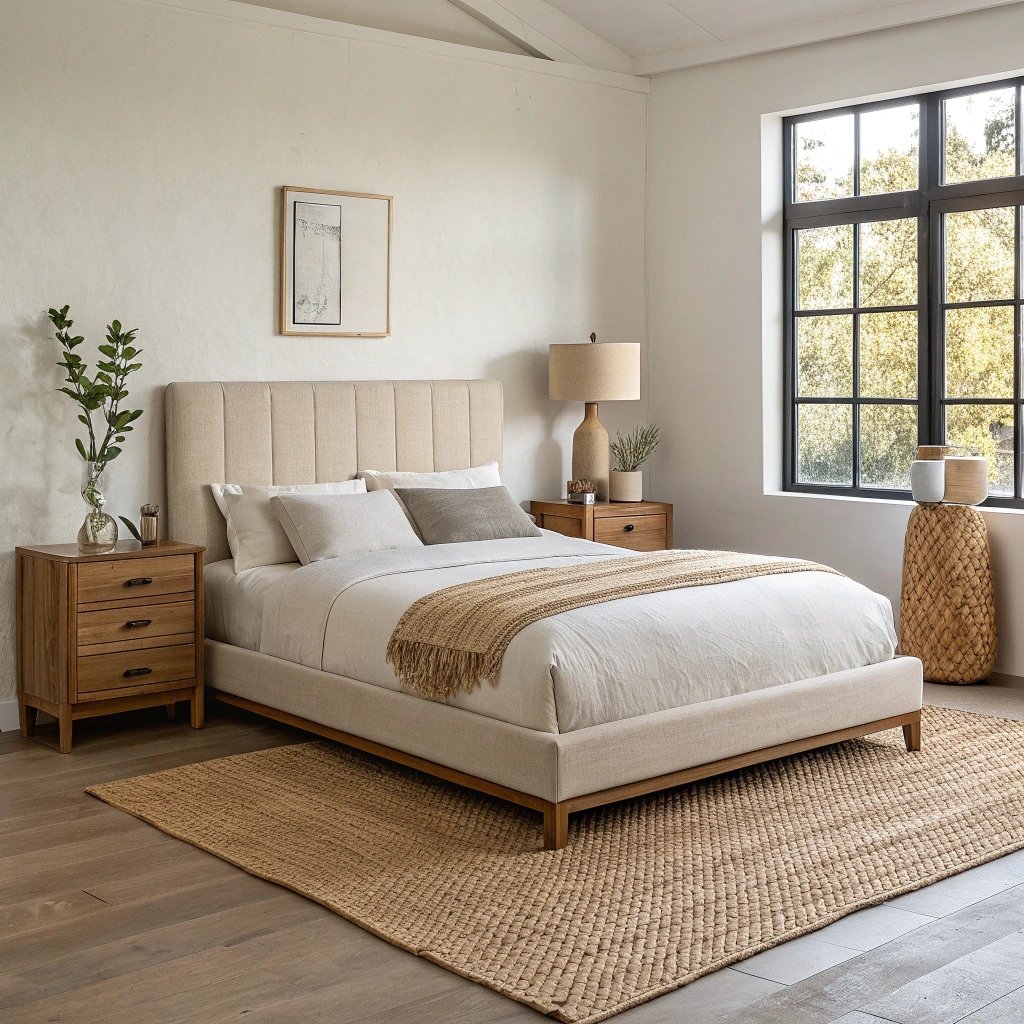
Keep the palette intentionally narrow—bone, oat, and warm white—so the eye relaxes. Start with a padded headboard, crisp linen sheets, and a wool or jute rug sized to frame the bed.
Nightstands stay simple and low; lamps are understated. Texture, not pattern, does the heavy lifting, and negative space remains part of the composition.
What makes something unique:
Vary sheen inside the same color family: matte walls, soft-lustre bedding, and a subtle sheen on lamp bases. Add one sculptural ceramic piece that reads like jewelry for the room.
This controlled neutrality prevents visual fatigue and creates a flexible backdrop that adapts seasonally with nothing more than a throw or pillow swap.
2) Japandi Low-Profile Calm
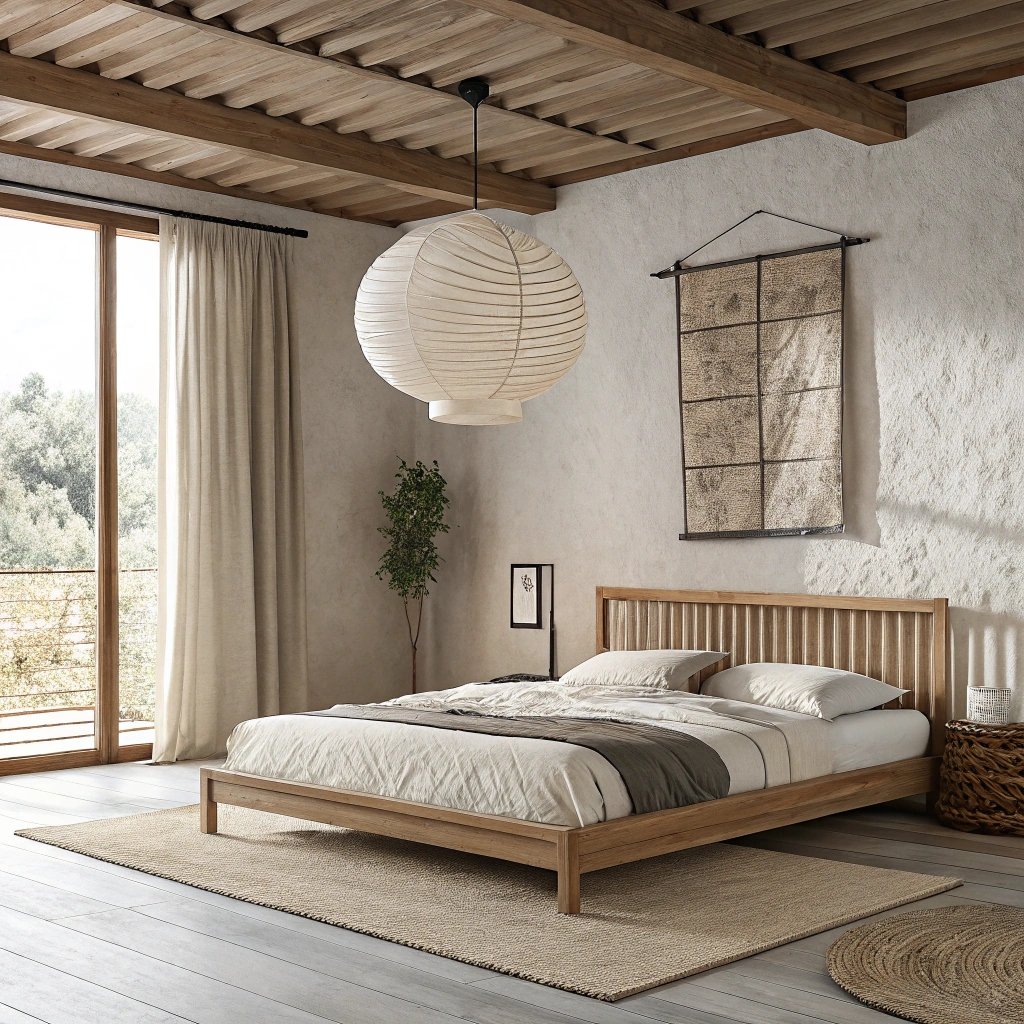
Blend Japanese restraint with Scandinavian warmth: low platform bed, pale wood nightstands, and gauzy linen curtains that skim the floor.
Surfaces stay mostly clear, with a book stack and a single branch in water. The emphasis is on breathability—fewer pieces, more circulation, and honest materials that invite touch.
What makes something unique:
Use a paper-lantern pendant (around 3000K) for flattering evening light and specify soft radiuses at furniture corners to remove visual sharpness.
A slatted-wood headboard panel introduces rhythm without pattern. The gentle geometry makes the room feel timeless, camera-ready, and easy to maintain.
3) Monochrome Black & White Discipline
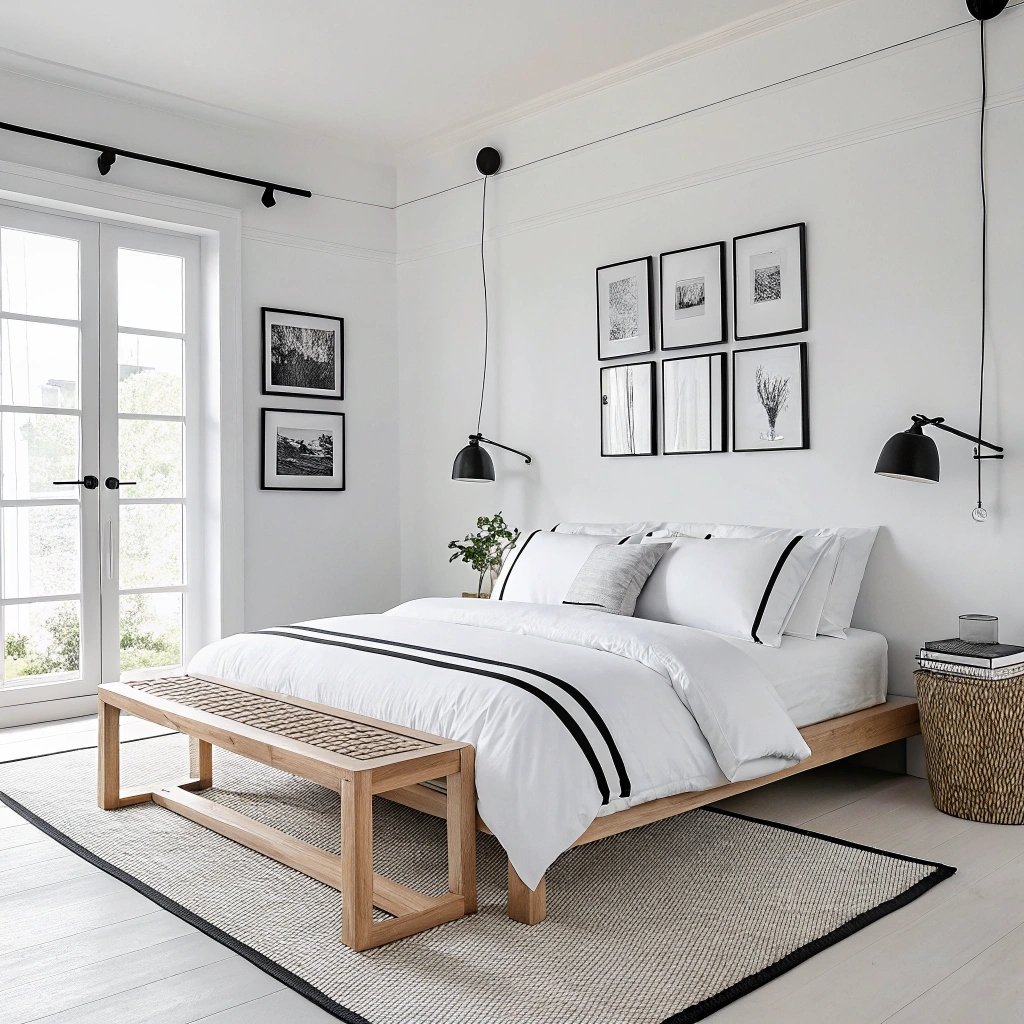
High-contrast minimalism sharpens lines and simplifies choices. Keep walls bright white, introduce a thin black frame around the mirror and art, and use matte black for hardware and lamps.
Bedding stays crisp with black-edge piping. Patterns are nearly absent; silhouette is the star.
What makes something unique:
Warm the scheme with a light oak bench or a natural linen curtain to prevent starkness. Choose warm 3000K bulbs so white reads soft, not clinical.
Limiting accents to a single wood tone preserves discipline while adding human warmth, keeping the room bold yet livable.
4) Textured Minimalism (Limewash & Linen)
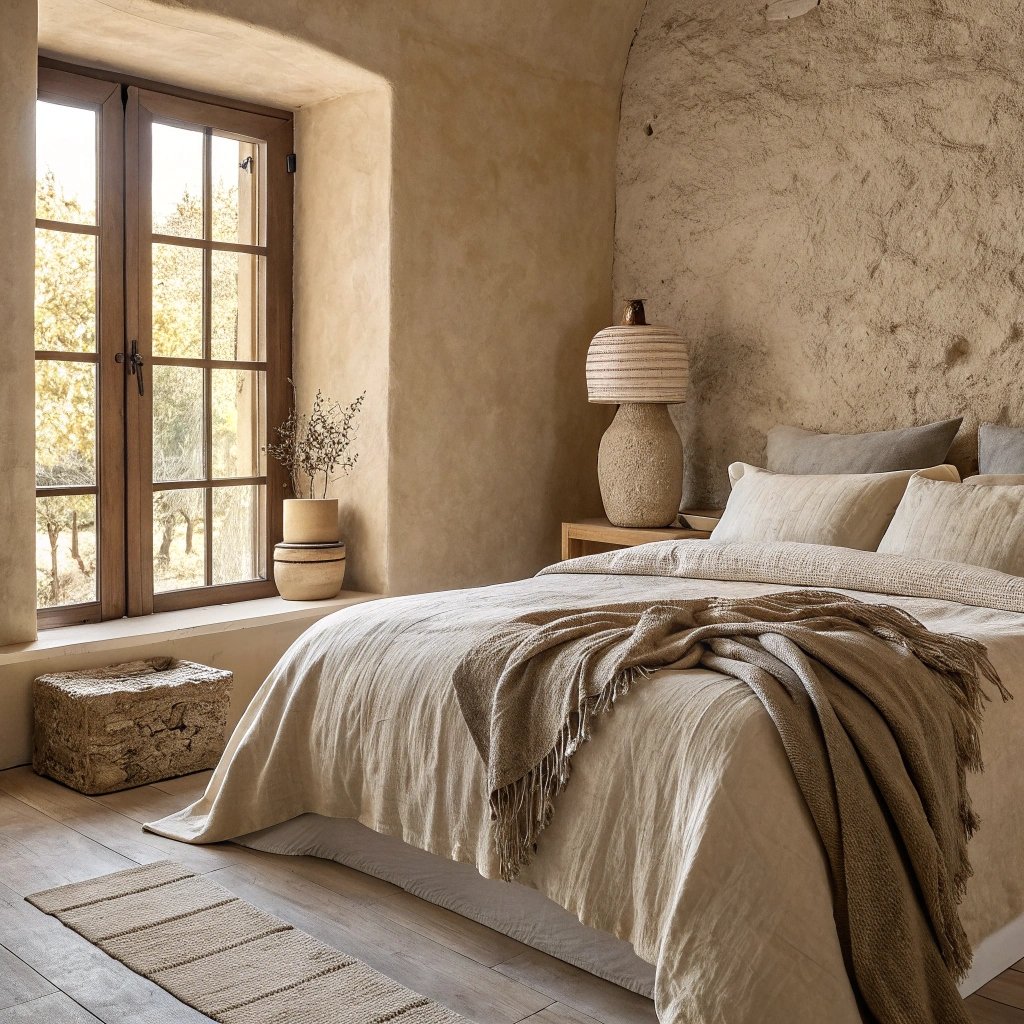
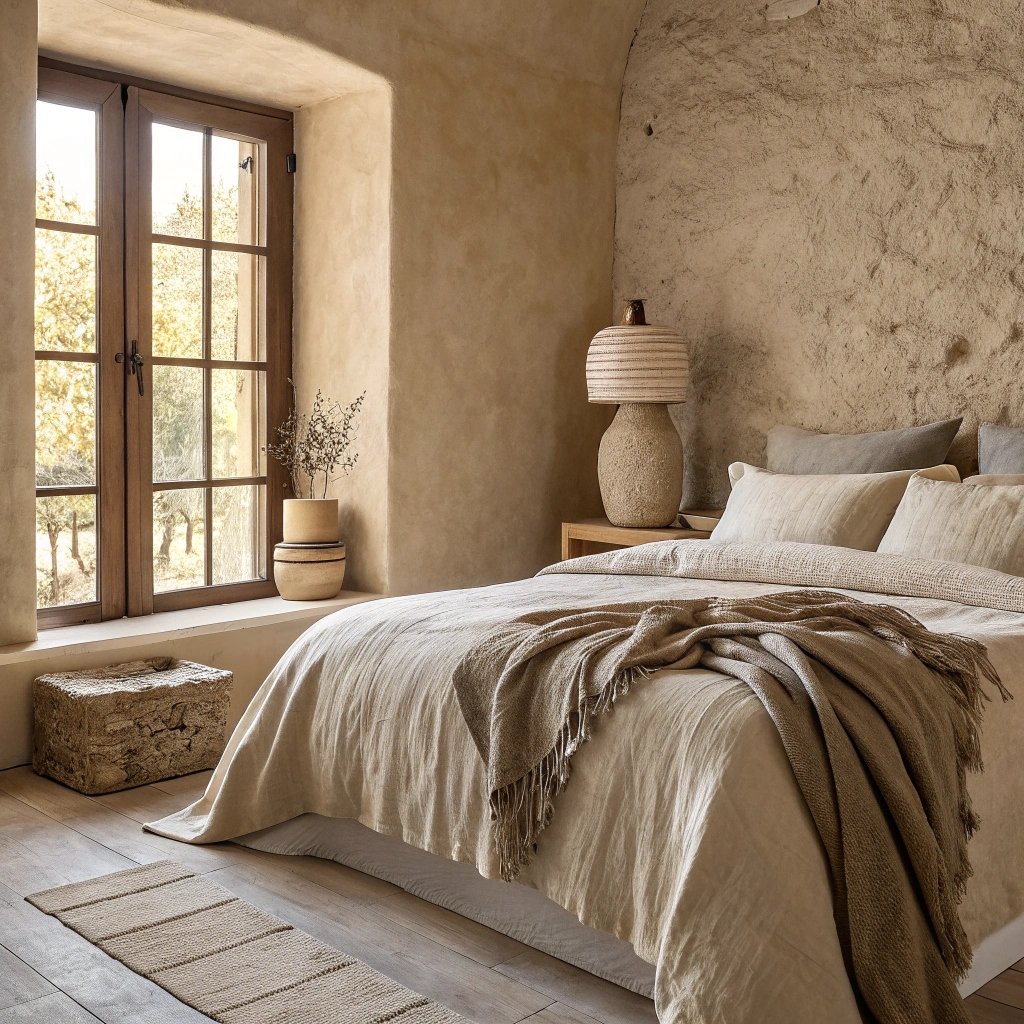
When pattern is dialed down, texture can sing. Limewashed walls introduce soft movement, while heavy linen bedding and wool throws add depth without noise.
Choose a plaster or microcement bedside ledge instead of a table to keep lines uninterrupted and easy to wipe.
What makes something unique:
Finish discipline is key: matte, porous surfaces that age well and reduce glare. Add a ribbed ceramic lamp and a stone tray for a tactile trio. The result is quiet luxury—photogenic, forgiving of daily life, and deeply restful at night.
5) Low Platform + Oversized Headboard
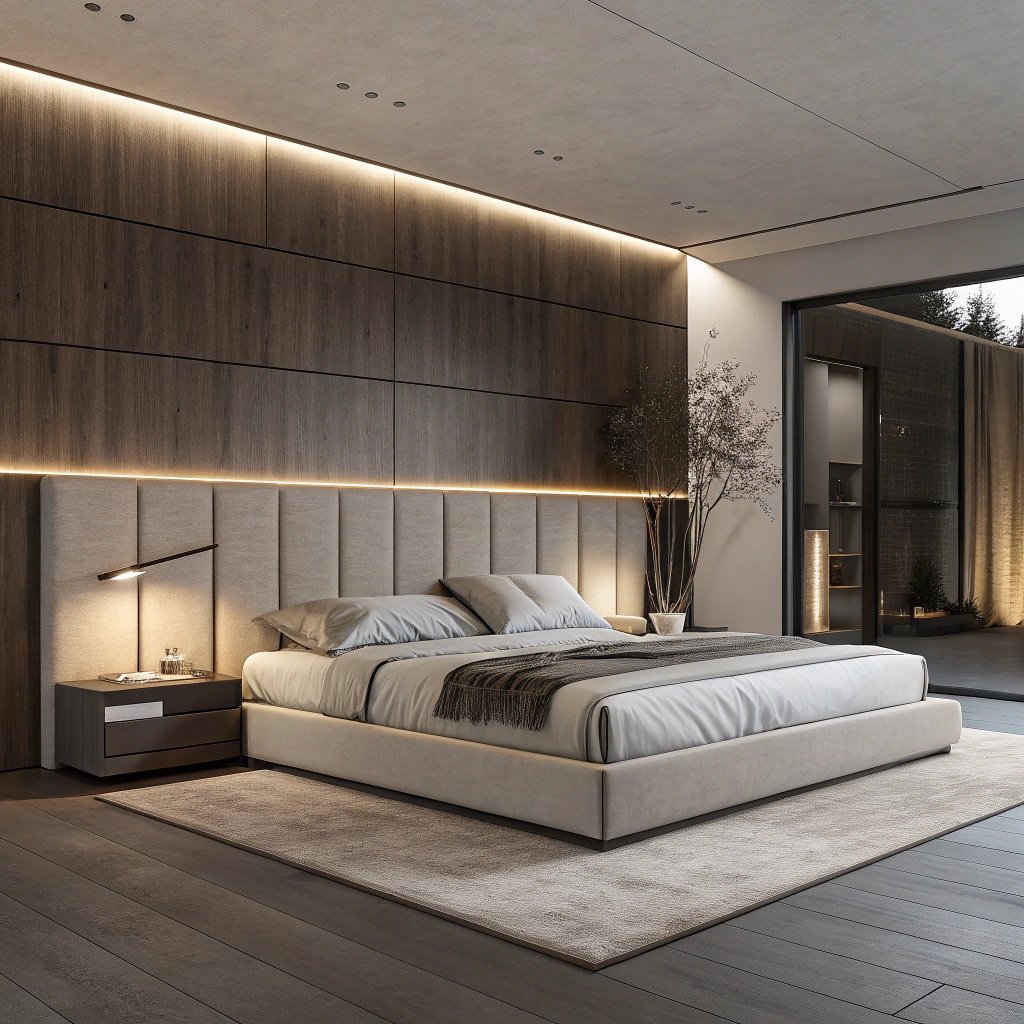
A low bed visually expands tight rooms. Pair it with an oversized headboard—channel-tufted, paneled wood, or upholstered slab—to anchor the wall without extra furniture.
Keep art minimal or omit it entirely; the headboard becomes the composition.
What makes something unique:
Color-match the headboard to the wall within one tone for a tailored, near-built-in effect. Add backlighting that grazes up the wall to lift the ceiling line visually.
You get presence, height, and softness while maintaining a clean floor and an uncluttered silhouette.
6) Seamless Built-In Wardrobes
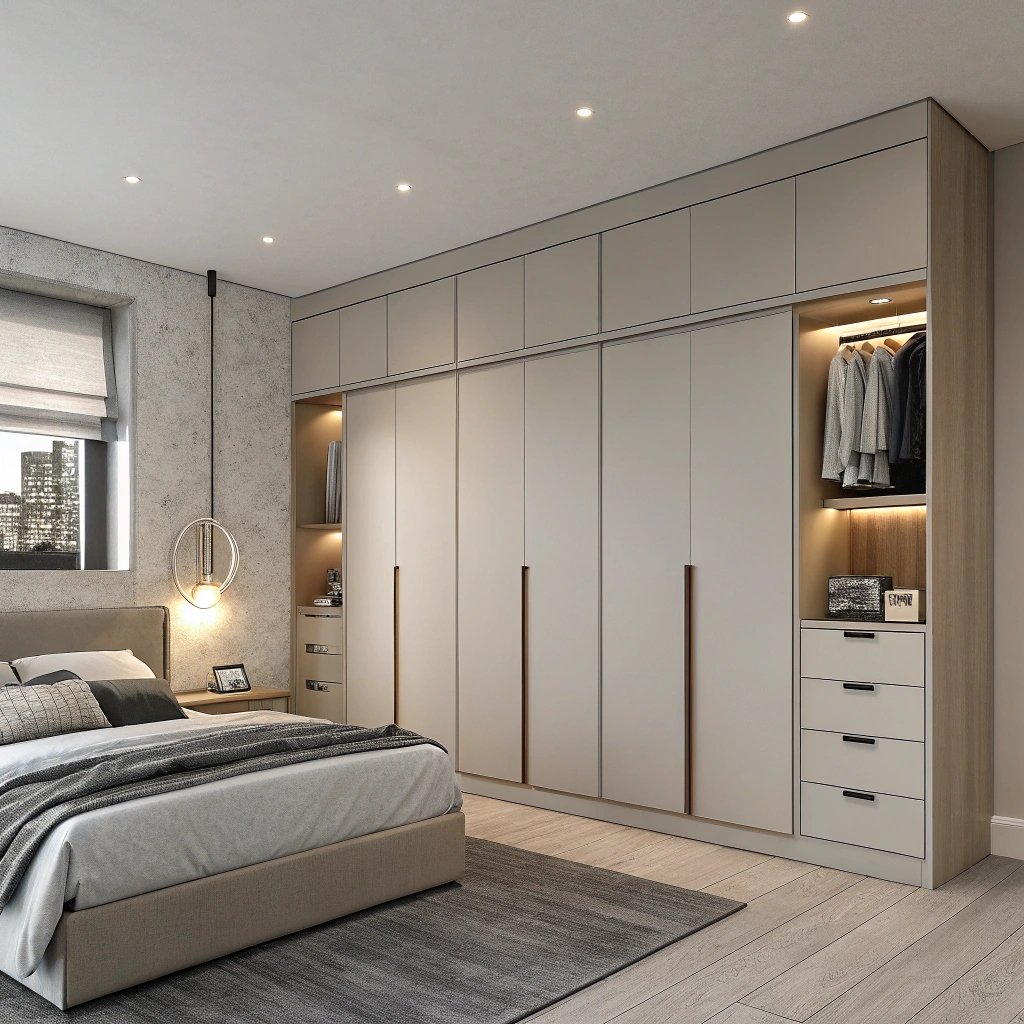
Turn one wall into a calm plane with floor-to-ceiling wardrobes and integrated pulls. Inside, double-hang rails, drawer dividers, and a tray for accessories make a dresser optional. The facade color-matched to walls reads like architecture, not storage.
What makes something unique:
Add toe-kick LEDs for night navigation and a shallow niche above the bed for books, replacing busy nightstands. This removes visual interruptions and dust traps, making the room feel hotel-quiet and easy to reset daily.
7) Floating Nightstands & Wall Lamps
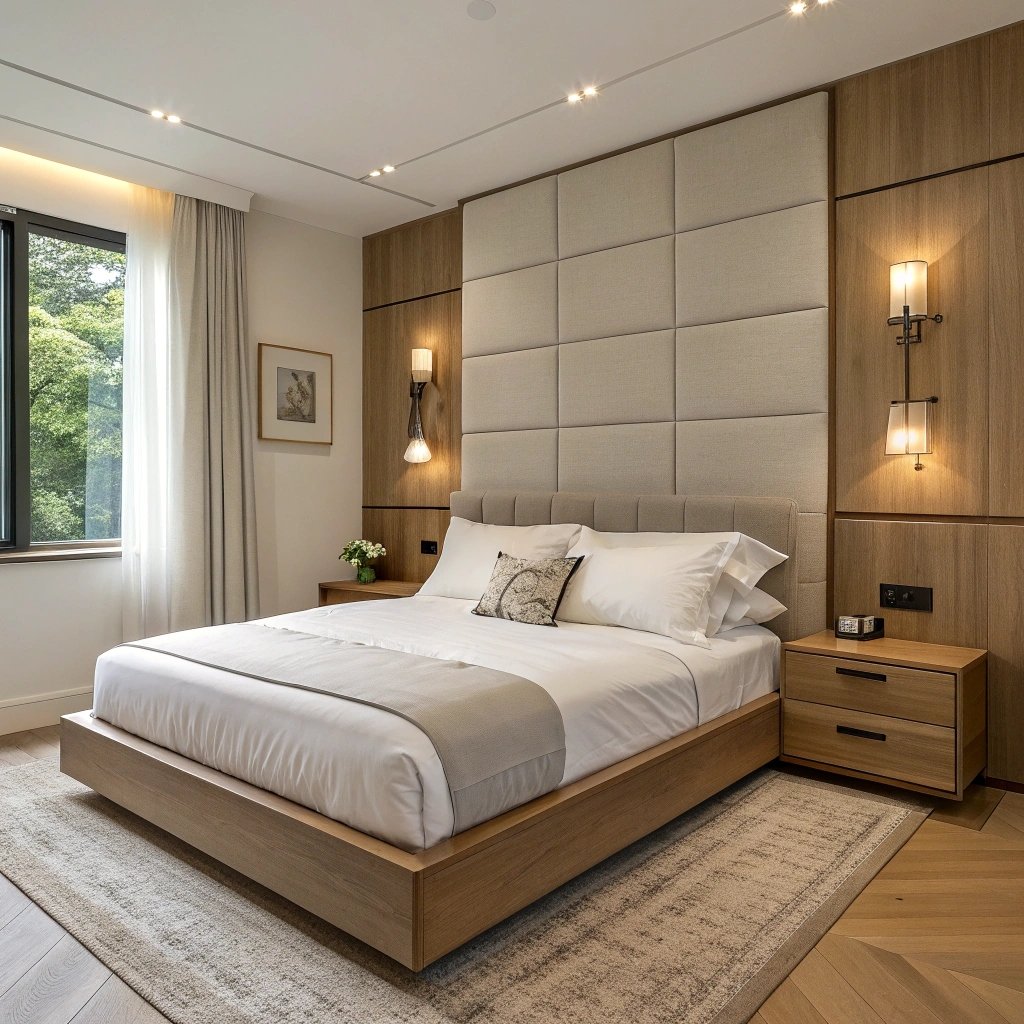
Free the floor to gain visual square footage. Floating nightstands keep cleaning simple and underscore the bed’s low line. Replace table lamps with wall-mounted sconces so surfaces remain clear and the composition stays light.
What makes something unique:
Mount sconces on a narrow upholstered or timber panel that hides cords and adds a subtle material accent.
Choose a tray-top nightstand sized to mattress height for a tidy, custom feel. The mix keeps essentials reachable, but the look remains featherlight.
8) Single Artwork, Big Impact
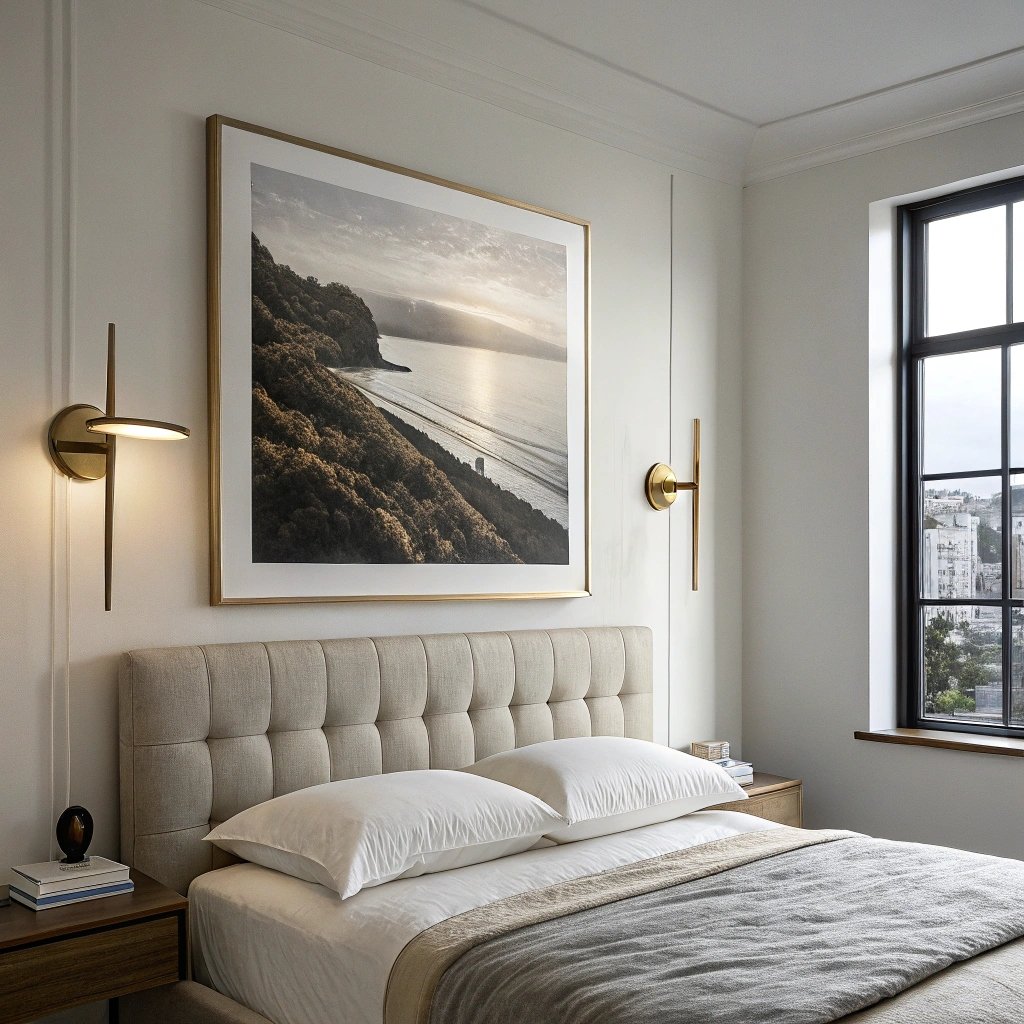
One large piece of art centered above the bed can replace multiple small frames. The generous negative space around it becomes part of the design language.
Keep the palette of the piece aligned with the room’s neutrals to avoid color clutter.
What makes something unique:
Use a micro-bezel frame in a material that echoes another element—brass picture light with brass lamp finials, for instance. A wide, creamy mat gives breathing room.
This restraint feels curated, not sparse, and the focus promotes calm.
9) Biophilic Minimal
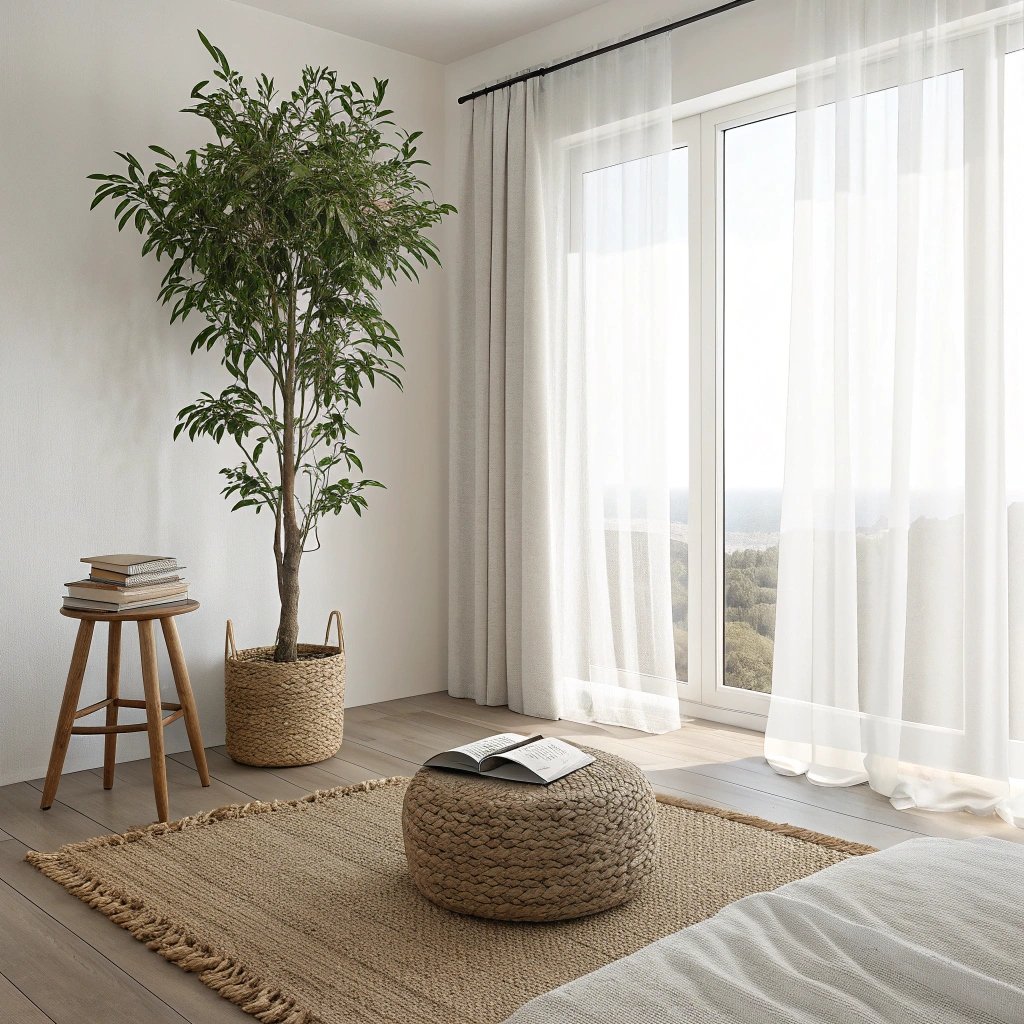
Instead of scattered plants, choose one statement tree—olive, rubber, or ficus—in a matte stone planter.
Pair with natural fibers: linen drapery, wool blanket, and a sisal or jute rug. Fewer, larger organic gestures feel cleaner and more serene.
What makes something unique:
Ripples of light through sheer curtains produce moving shadows that animate an otherwise quiet palette.
Keep finishes matte so greens read rich and lifelike. The plant becomes sculpture, bringing seasonal change without new objects.
10) Warm Minimal Modern Rustic
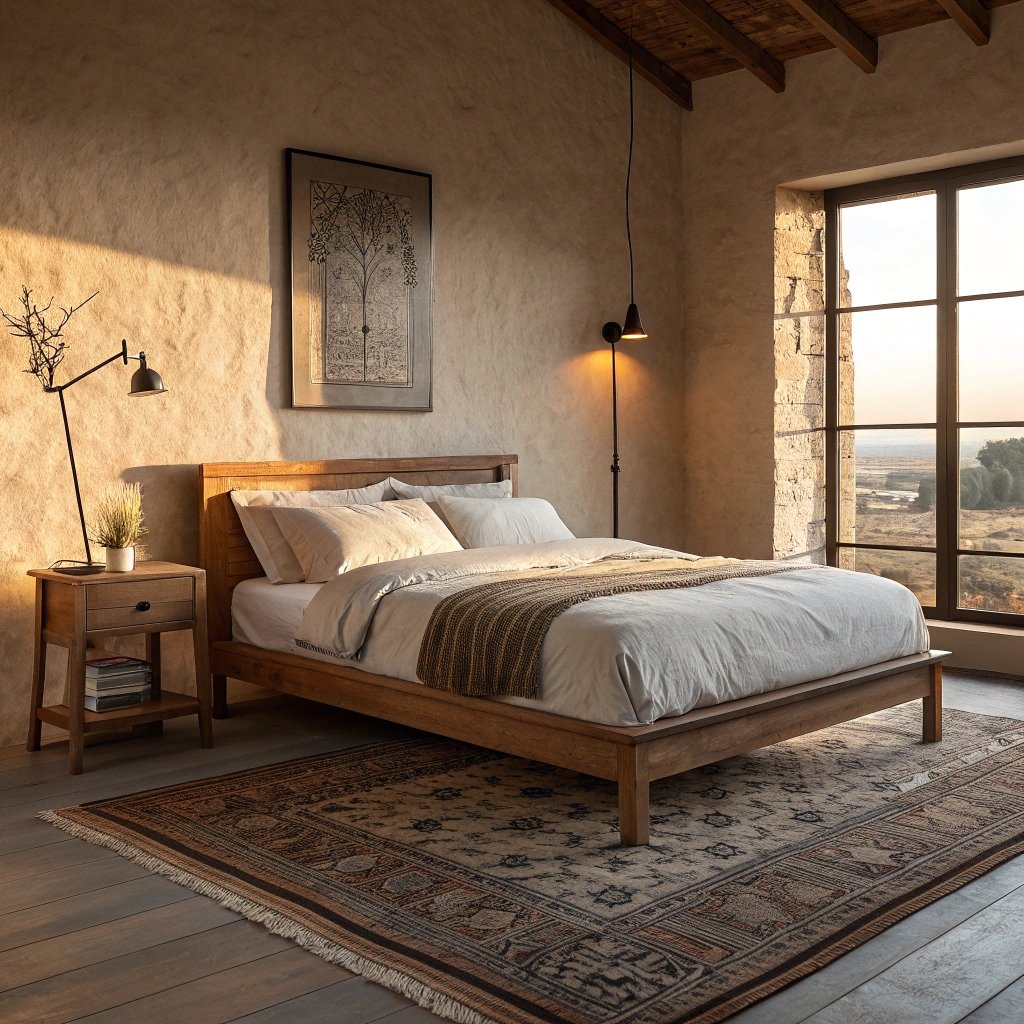
Mix planed oak, hand-finished plaster, and cast-iron accents for a minimal look with soul. Keep forms simple—rectilinear bed, blocky nightstands—but let materials carry character. Textiles stay solid and tactile.
What makes something unique:
Repeat materials across the room deliberately: oak bed, oak bench, iron lamp base. A single vintage rug in a muted palette adds history without breaking minimal rules.
The room feels grounded and timeless, not trend-chasing.
11) Soft Curves & Arches
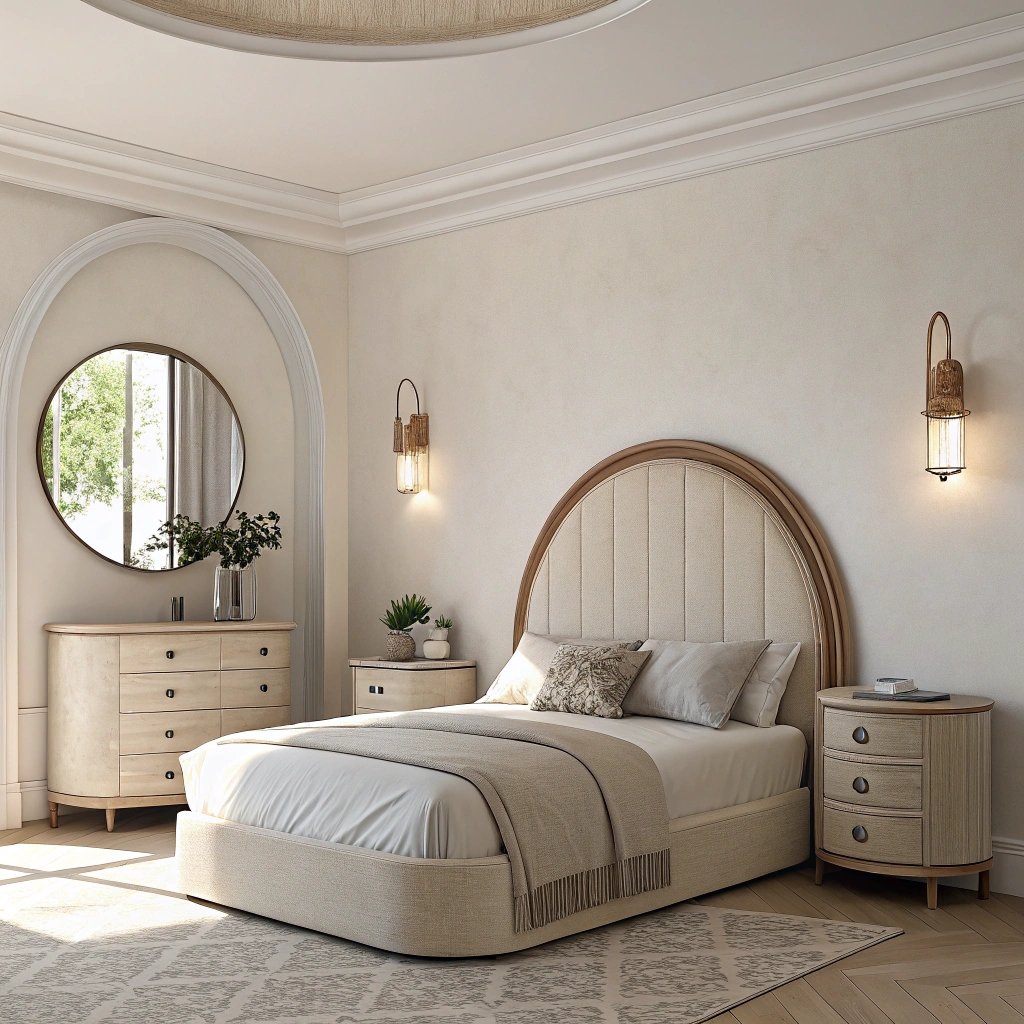
Swap sharp edges for rounded forms—arched headboard, oval mirror, bullnose shelf. Curves reduce visual tension and make small rooms feel gentler.
Keep the number of pieces low; let the geometry do the work.
What makes something unique:
Echo the arc subtly: mushroom-shade sconces, curved-edge bench. Repetition creates cohesion without theme-park vibes.
The softened profile photographs beautifully and supports a sleepy, restorative mood.
12) Hotel-Calm Lighting Layers
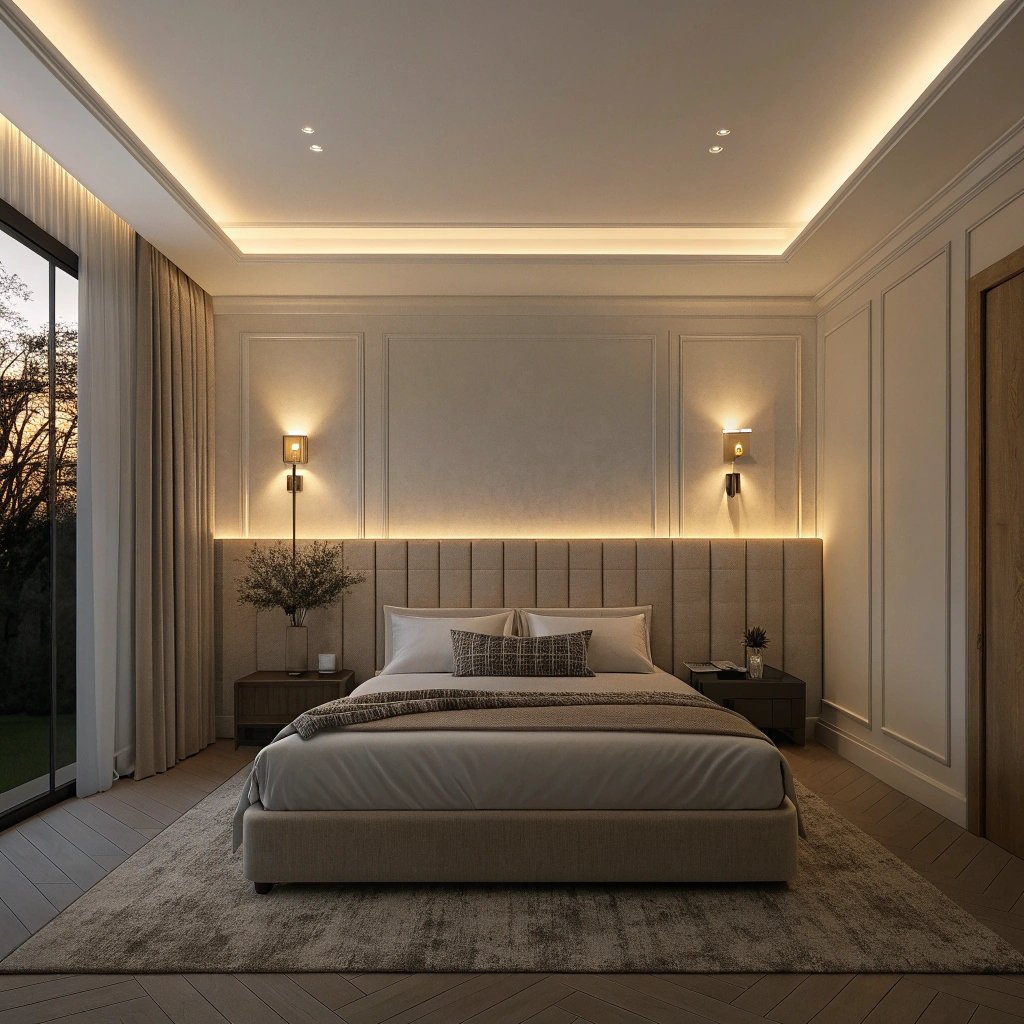
Design lighting like a boutique suite: ambient ceiling light, face-level sconces, and a hidden accent such as a headboard grazer or toe-kick LED. Warm temperatures (2700–3000K) flatter skin and textiles.
What makes something unique:
Separate dimmers create scenes—Read, Wind Down, Night Path. A tiny picture light over a single shelf elevates a pared-back vignette. The light plan becomes the decor, so you need fewer objects.
13) Small Room, Big Serenity
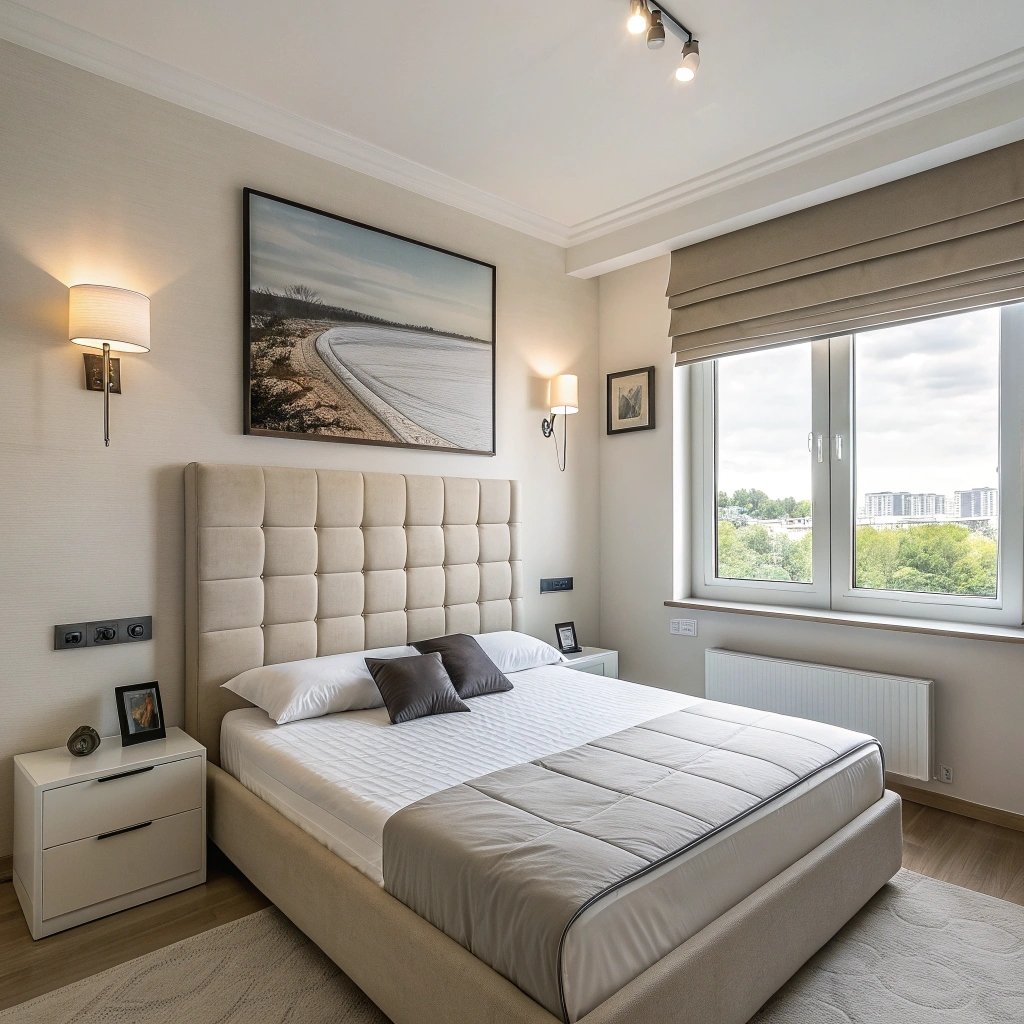
Scale is everything in a tiny footprint: a slim bed frame, wall-mounted lamps, and a single oversized art piece.
Use a mirror across from the window to widen sightlines and opt for a narrow floating ledge instead of nightstands.
What makes something unique:
Layer window treatments—sheer Roman inside, full-length curtain outside—for depth without bulk. Keep the color story tight and let one natural material (oak or linen) repeat. The result feels tailored, not cramped.
14) Muted Color Drench
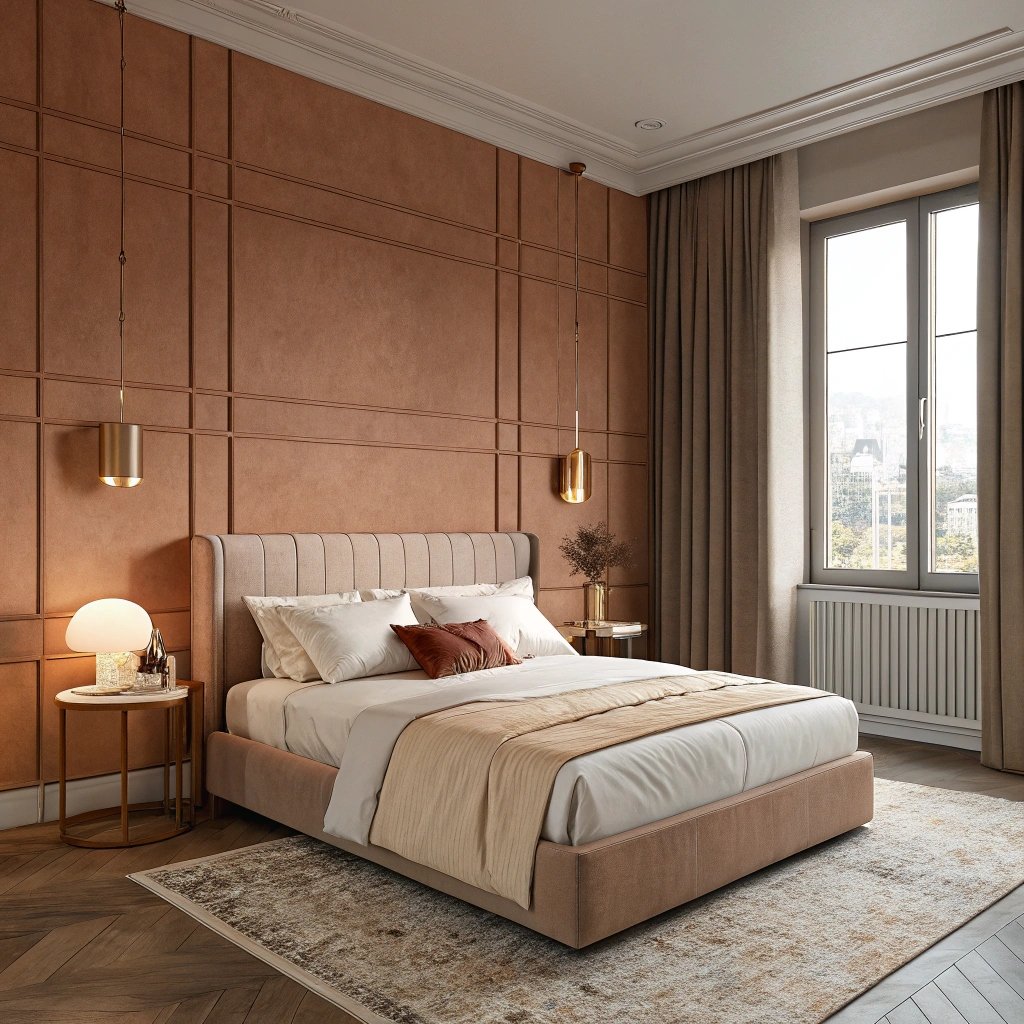
Choose one sophisticated hue—mushroom, olive gray, or muted clay—and wrap walls, trim, and even the headboard. Keep bedding in lighter tints of the same color family for low-contrast calm.
What makes something unique:
Play with sheen: matte walls, satin headboard fabric, velvety throw. Two or three textures in one color produce richness without busy pattern. It looks editorial yet remains relaxing.
15) Material-Led Minimal (Stone, Wood, Metal)
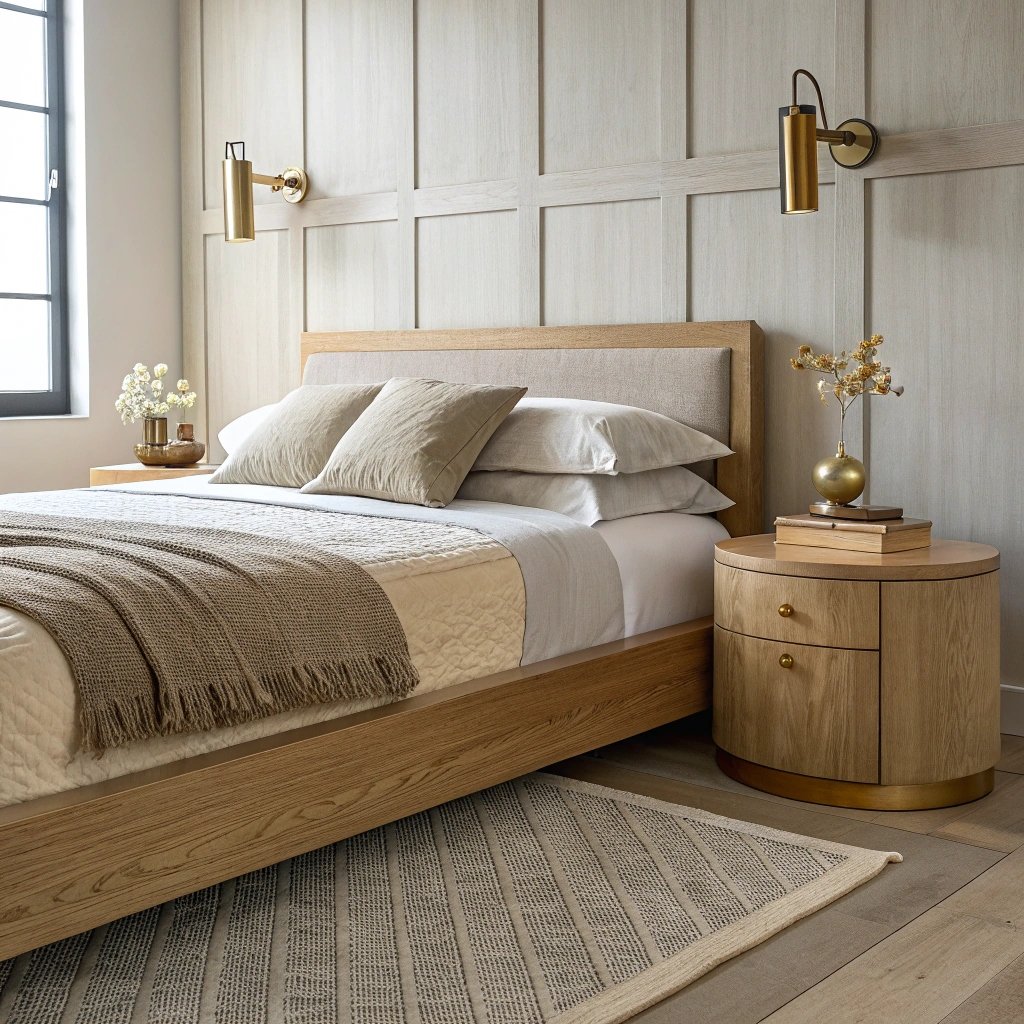
Let materials tell the story: a stone-topped night table, oak bed, and brushed-brass reading lights. Patterns are absent; grain and veining supply interest that ages gracefully. The palette stays neutral and warm.
What makes something unique:
Echo each material in one other spot—a stone tray on the dresser, a brass picture light, oak frame around a mirror. This repetition feels deliberate but quiet, raising perceived quality without adding objects.
16) Minimalist Vintage Blend
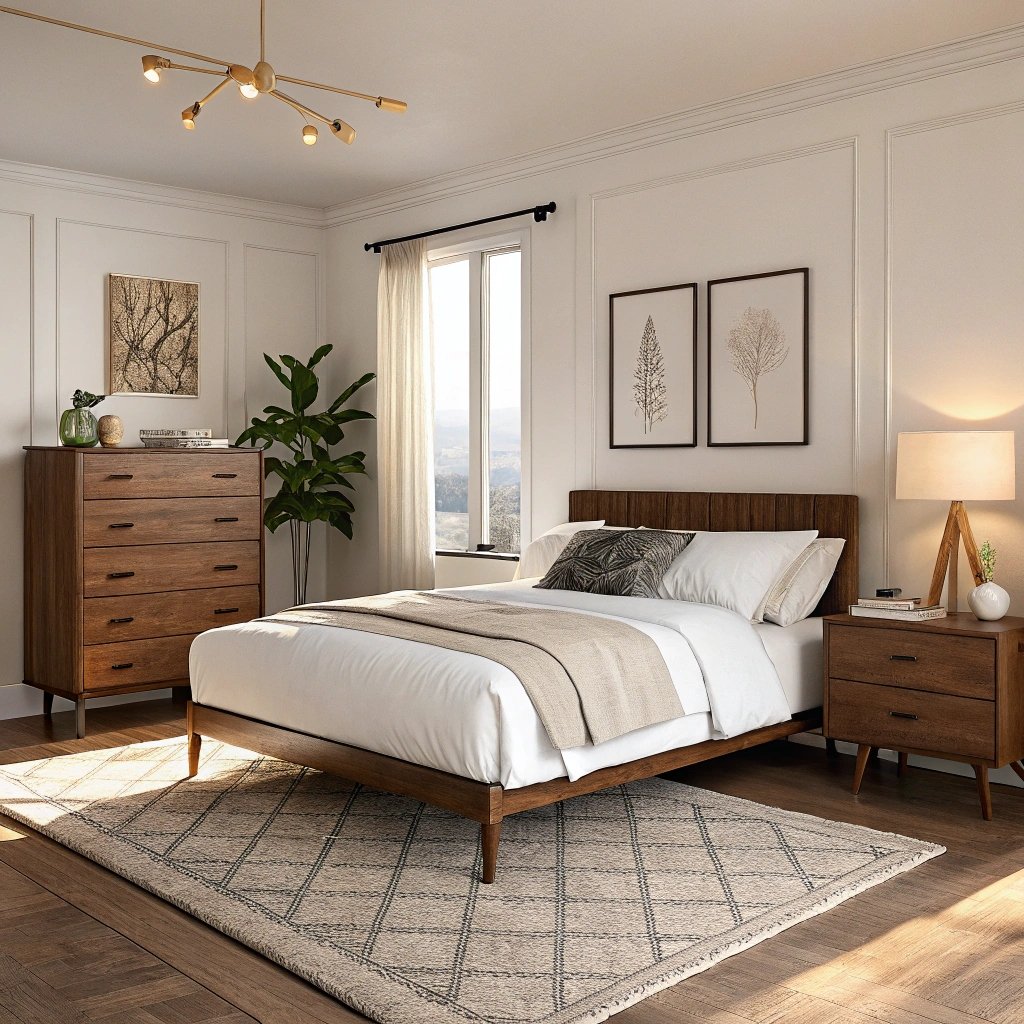
Use one well-chosen vintage piece—a mid-century dresser or antique trunk—against otherwise minimal forms. Keep the rest restrained to let patina breathe. The contrast prevents a showroom vibe and adds depth.
What makes something unique:
Bridge eras with modern hardware or a clean-lined bed. Limit color on the vintage piece; let wood tone be the accent. This collected calm feels personal yet disciplined.
17) Tech-Lite, Hidden Ease
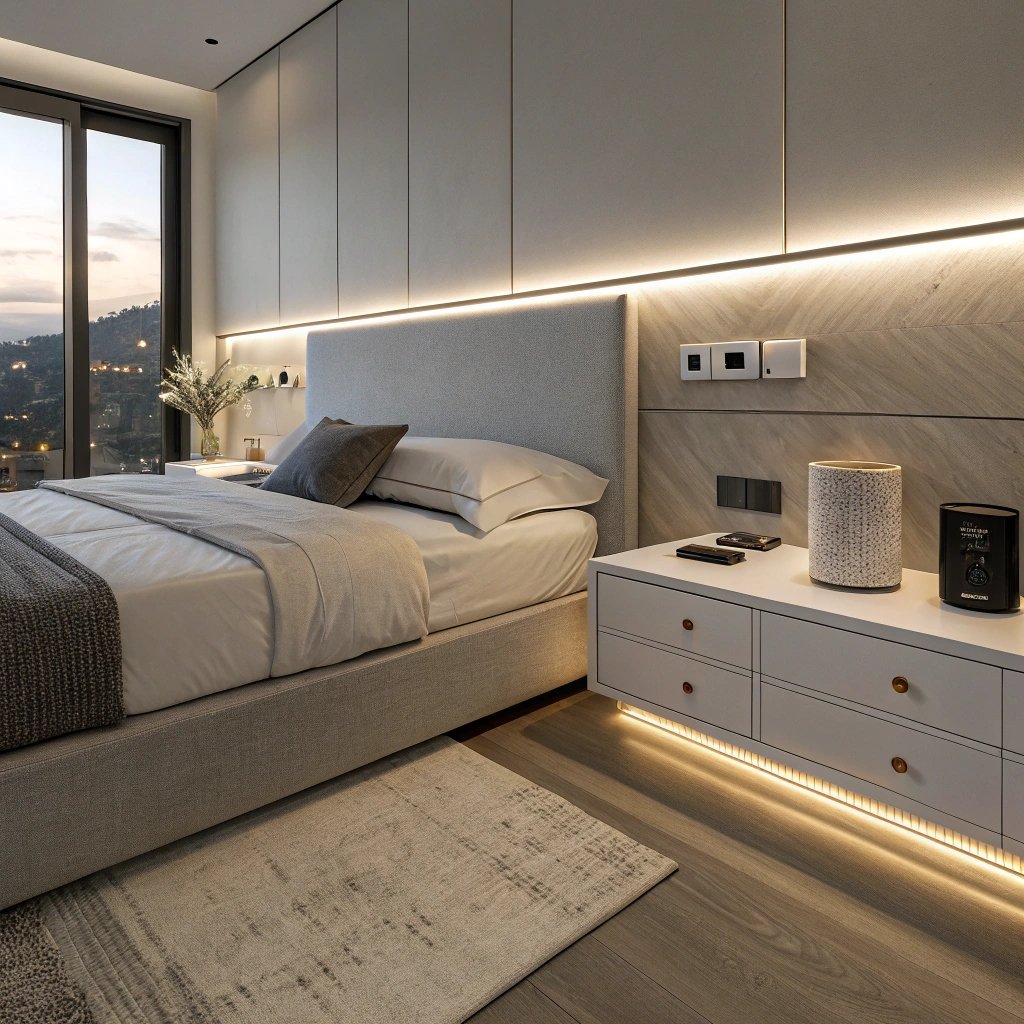
Integrate tech without visual noise: motion-sensor toe-kick lights, concealed cable management, and a small, fabric-covered speaker that blends with textiles. Keep screens out of sight or out of the room.
What makes something unique:
Use a headboard panel to hide outlets and chargers, with a magnet catch for easy access. A tunable bedside lamp shifts from 4000K task to 2700K wind-down, supporting circadian rhythm while staying invisible in the design.
18) Sustainable Minimalist Choices
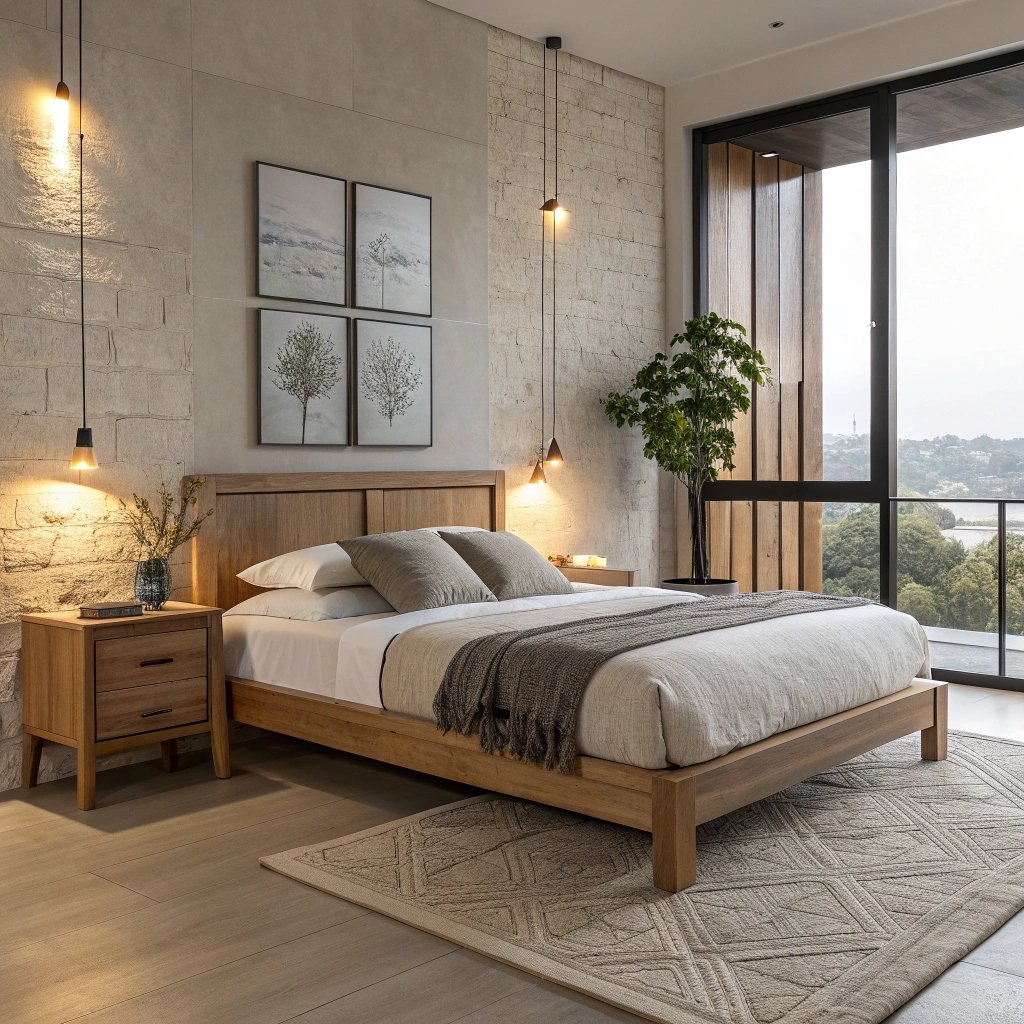
Choose low/zero-VOC finishes, FSC-certified or reclaimed wood, and durable textiles like linen and wool.
High-CRI LEDs keep colors honest, and good ventilation protects both lungs and materials. Refillable bottles reduce visual and plastic clutter.
What makes something unique:
Sustainability can look luxe when texture leads: reclaimed oak fronts, solid-brass hardware that patinas, and stone that ages gracefully.
Plan a donation basket in the closet to keep the edit ongoing and the room light—minimalism as a habit, not a weekend project.
Quick Tips to Nail a Minimalist Bedroom
Pick one hero move (built-ins, color-drench, or lighting) and support it with two simple tweaks.
Standardize finishes—hardware, lamps, frames—for visual cohesion.
Edit quarterly; minimalism lasts when everything has a home and purpose.

